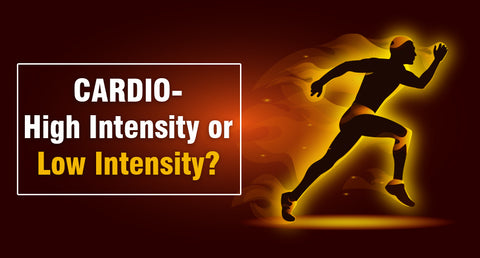Planning to get back in shape? Then you should involve some sort of cardio in your workout regime!
Cardiovascular exercise or Cardio is simply an activity that raises your heart rate while performing any activity while improving your fitness, stamina and burning calories. Eg brisk walk, dancing, swimming, etc.
What type of cardio should you do?
Based on intensity, there are two types of cardio.
- HIIT (High-Intensity Interval Training):-
It consists of short burst vigorous activity, where you switch back and forth, coupled with low-moderate intensity workout. An example would be a 30-second sprint followed by a four-minute steady pace walk, to cool down and then repeating it as per your capacity and stamina.
- LISS (Low-Intensity Steady State Cardio):-
This is purely a low to moderate level of intensity workout for a duration of at least 40-50 minutes. Eg, walking on a treadmill or riding the bike at a relaxed level.
In other words, HIIT involves pushing your body to extend its limit for a short burst of time whereas, during LIIS, there is a low level of exertion over an extended period.
If you want to fine-tune your results and reach your goals faster, both types help provide you with different benefits!
Ways to change your metabolism

As we all know, higher the metabolism, better is the weight loss!
- Increase in muscle mass
- Increase in muscle oxidative capacity
Studies show that greater fat loss through high-intensity training is because of the increase in oxidative capacity as it increases mitochondrial capacity which is the storehouse of energy, where ATP is made and fat is burned out. On the other hand, with LISS you’re only burning calories at that time, as there is no boost in metabolism. Additionally, with HIIT you are not just burning calories at that time, but you are also increasing your muscle oxidative capacity which increases your metabolism to burn calories even later i.e. close to 24-hour energy expenditure.
The human body is very adaptive, for instance, if you are practising only LISS cardio for a long time, then after certain weeks or months your body weight will become stagnant. This happens as your body metabolism starts to adjust with low-intensity exercises.
A study conducted by Wilson et al. showed that LISS causes more muscle loss than HIIT because when you’re doing LISS (fast-paced walking), you are not able to activate muscles the same way as you were while lifting weights. Eg if you compare a sprinter’s body composition to a marathon runner’s, then who would have more muscle mass?
Powerful Performance Predictors :
Lactate Threshold (LT):- The maximal effort or intensity that an individual can maintain for a while with little or no lactate in the blood.
Anaerobic Threshold (AT):- The point during exercise when your body must switch from aerobic to the anaerobic energy system. Our muscles can burn glucose (blood sugars) and through aerobically (with oxygen) and anaerobically(without oxygen).
The AT and LT help to determine which type of work produces more ATP (Adenosine Triphosphate). ATP is a quick burst of energy that we get when we perform any activity. For instance, every time you do a bicep curl, you are release energy or ATP.
HIIT V/S LISS
- HIIT form of cardio produces better changes in exercise capacity as compared to LISS cardio.
- High-intensity training hits the AT and LT, that causes the body to make required metabolic changes. Whereas, if you are doing LISS, you are considered to be performing below the AT and LT. A simple test is being able to hold a conversation while walking. When doing HIIT you are above the AT and LT and it's the time when you push for greater improvement in metabolism which thus leads to better fat loss over time. (Chris.Eric (2011)
Benefits
- HIIT is quicker, more effective for fat loss in a shorter duration, whereas LISS takes a longer time to burn fat.
- HIIT makes some remarkable changes in the metabolism by activating the muscle fibres and oxygen capacity, hence increases muscle mass.
- LISS is great for increased energy, better blood flow, a stronger heart, overall cardiovascular health, and in the initial stages of a weight loss program, effective for fat burning.
Exercise Facts and Benefits
- HIIT should not be performed more than 5 days a week because it may have a negative impact on your weight training, whereas it is safe to perform LIIS. Also, HIIT won’t be suitable for people with orthopaedic, cardiac or other physiological condition as it may lead to injury.
Bottom line is, you should practice both types of cardio.
HIIT and LISS performed on rotational basis seem to be the best formula. Both have their unique features and health benefits.
References:-
- Wilson, et al. Concurrent Training: A Meta-Analysis Examining Interference of Aerobic and Resistance Exercises. J Strength Cond Res. 26(8),2293-307
- Martinez. C., & Martinez. E.(2011).HIIT vs LISS – Which Cardio Kicks Better Tail? Retrieved from http://www.theissnscoop.com/hiit-vs

